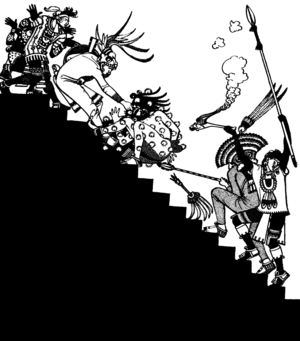
Back التضحية البشرية في ثقافة الآزتيك Arabic Opferkult der Azteken German Ανθρωποθυσίες Αζτέκων Greek Sacrificios humanos en la América prehispánica#Sacrificios Aztecas (mexicas) Spanish قربانی کردن انسان در فرهنگ آزتک Persian Sacrifice humain chez les Aztèques French Pengorbanan manusia dalam kebudayaan Aztek ID Sacrifici umani nella cultura azteca Italian 네슈틀라우알리 Korean Човечко жртвување кај Ацтеките Macedonian

Human sacrifice was common in many parts of Mesoamerica, so the rite was nothing new to the Aztecs when they arrived at the Valley of Mexico, nor was it something unique to pre-Columbian Mexico. Other Mesoamerican cultures, such as the Purépechas and Toltecs, and the Maya performed sacrifices as well and from archaeological evidence, it probably existed since the time of the Olmecs (1200–400 BC), and perhaps even throughout the early farming cultures of the region. However, the extent of human sacrifice is unknown among several Mesoamerican civilizations. What distinguished Aztec practice from Maya human sacrifice was the way in which it was embedded in everyday life. These cultures also notably sacrificed elements of their own population to the gods.[citation needed]
In 1519,[1] explorers such as Hernán Cortés conquered the Aztec capital of Tenochtitlan and made observations of and wrote reports about the practice of human sacrifice. Bernal Díaz del Castillo, who participated in the Cortés expedition, made frequent mention of human sacrifice in his memoir True History of the Conquest of New Spain.[2][3] There are a number of second-hand accounts of human sacrifices written by Spanish friars that relate to the testimonies of native eyewitnesses. The literary accounts have been supported by archeological research.
Since the late 1970s, excavations of the offerings in the Great Pyramid of Tenochtitlan, and other archaeological sites, have provided physical evidence of human sacrifice among the Mesoamerican peoples.[4][5][6] As of 2020, archaeologists have found 603 human skulls at the Hueyi Tzompantli in the archeological zone of the Templo Mayor.[7][8]
A wide variety of interpretations of the Aztec practice of human sacrifice have been proposed by modern scholars. Many scholars now believe that Aztec human sacrifice, especially during troubled times like pandemic or other crises, was performed in honor of the gods.[9] Most scholars of Pre-Columbian civilization see human sacrifice among the Aztecs as a part of the long cultural tradition of human sacrifice in Mesoamerica.
- ^ "Fall of Tenochtitlan", Wikipedia, 2021-02-07, retrieved 2021-02-16
- ^ Diaz de Castillo, Bernal (1917). "The True History of the Conquest of New Spain". The Geographical Journal. 49 (1): 206. Bibcode:1917GeogJ..49...61T. doi:10.2307/1779784. JSTOR 1779784.
- ^ Cite error: The named reference
Harner 1977 117–135was invoked but never defined (see the help page). - ^ Matos-Moctezuma, Eduardo (1986). Vida y muerte en el Templo Mayor. Fondo de Cultura Económica.
- ^ "Evidence May Back Human Sacrifice Claims" By Mark Stevenson
- ^ "Grisly Sacrifices Found in Pyramid of the Moon" By LiveScience Staff.
- ^ Gershon, Livia. "The Aztecs Constructed This Tower Out of Hundreds of Human Skulls". Smithsonian Magazine. Retrieved 2021-12-07.
- ^ Cite error: The named reference
:13was invoked but never defined (see the help page). - ^ Cite error: The named reference
ReferenceBwas invoked but never defined (see the help page).
© MMXXIII Rich X Search. We shall prevail. All rights reserved. Rich X Search